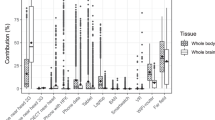Abstract
Epidemiological studies investigating whether mobile phone use is related to cancer risk have been conducted in many countries. The purpose of the work reported here was to introduce the dose metric in the exposure assessment, taking into account the spatial distribution of exposure. Distributions of specific absorption rate (SAR) inside 275 cases of brain tumors (participants in the Japanese epidemiological study) were estimated. Phones had been classified into four categories based on SAR distributions and technical specifications. Results were found to be highly dependent on phone categories. Contralateral tumors were generally categorized as non-exposed tumors (max SAR <2.5% of max SAR in the brain) and, for any phone category, the maximum SAR in 75% of the ipsilateral tumors was less than 15% of the maximum SAR in the brain. Three new exposure indices combining the duration and strength of exposure were created to be used in the Japanese epidemiological study on mobile phone use and the risk of gliomas and meningiomas.















Similar content being viewed by others
References
Yamaguchi N (2002) Mobile phone use and brain tumors: Japanese epidemiological study, URSI XXVIIth General Assembly, K5-2, 2002
Takebayashi T, Akiba S, Kikuchi Y, Taki M et al (2006) Mobile phone use and acoustic neuroma risk in Japan. Occup Environ Med 63:802–807
Hardell L, Nasman A, Pahlson A, Hallquist A, Hansson Mild K (1999) Use of cellular telephones and the risk of brain tumors: a case–control study. Int J Oncol 15:113–116
Muscat JE, Malkin MG, Thompson S, Shore RE et al (2000) Handheld cellular telephone use and risk of brain cancer. JAMA 284:3001–3007
Inskip PD, Tarone RE, Hatch EE, Wilcosky TC et al (2001) Cellular-telephone use and brain tumors. N Engl J Med 344:79–86
Auvinen A, Hietanen M, Luukkonen R, Koskela RS (2002) Brain tumors and salivary gland cancers among cellular telephone users. Epidemiology 13:356–359
Hardell L, Hallquist A, Hansson Mild K, Carlberg M et al (2002) Cellular and cordless telephones and the risk of brain tumours. Eur J Cancer Prev 11:377–386
Muscat JE, Malkin MG, Shore RE, Thompson S et al (2002) Handheld cellular telephones and risk of acoustic neuroma. Neurology 58:1304–1306
Christensen HC, Schüz J, Kosteljanetz M, Skovgaard Poulsen H et al (2004) Cellular telephone use and risk of acoustic neuroma. Am J Epidemiol 159:277–283
Lönn S, Ahlbom A, Hall P, Feychting M (2004) Mobile phone use and the risk of acoustic neuroma. Epidemiology 15:653–659
Christensen HC, Schüz J, Kosteljanetz M, Skovgaard Poulsen H et al (2005) Cellular telephones and risk of brain tumors: a population-based, incident case–control study. Neurology 64:189–1195
Hardell L, Carlberg M, Hansson Mild K (2005) Case–control study on cellular and cordless telephones and the risk for acoustic neuroma or meningioma in patients diagnosed 2000–2003. Neuroepidemiology 25:452–456
Lönn S, Ahlbom A, Hall P, Feychting M (2005) Long term mobile phone use and brain tumor risk. Am J Epidemiol 161:526–535
Schoemaker MJ, Swerdlow AJ, Ahlbom A, Auvinen A et al (2005) Mobile phone use and risk of acoustic neuroma: results of the Interphone case–control study in five North European countries. Br J Cancer 93:842–848
Hepworth SJ, Schoemaker MJ, Muir KR, Swerdlow AJ et al (2006) Mobile phone use and risk of glioma in adults: case–control study. Br Med J 332:883–887
Schüz J, Böhler E, Berg G, Schlehofer B et al (2006) Cellular phones, cordless phones and the risks of glioma and meningioma (Interphone study group Germany). Am J Epidemiol 163:512–520
Nagaoka T, Watanabe S, Sakurai S, Kunieda E et al (2004) Development of realistic high-resolution whole-body voxel models Japanese adult male and female of average height and weight and application of models to radio-frequency electromagnetic-field dosimetry. Phys Med Biol 49:1–15
Kuster N, Kastle R, Schmid T (1997) Dosimetric evaluation of handheld mobile communications equipment with known precision. IEICE Trans Commun E80-B:645–652
Recommended practice for determining the peak spatial-average specific absorption rate (SAR) in the human body due to wireless communications devices: measurement techniques, IEEE Standard 1528, 2003
Human exposure to radio frequency fields from hand-held and body-mounted wireless communication devices—human models, instrumentation, and procedures—Part 1: Procedure to determine the specific absorption rate (SAR) for hand-held devices used in close proximity to the ear (frequency range of 300 MHz to 3 GHz), IEC 62209-1
Wake K, Watanabe S, Taki M (2005) Estimation of 3D SAR distributions from mobile phone compliance testing data for the local exposure assessment in epidemiological study, URSI XXVIIIth General Assembly, KA-5, 2005
Wake K, Watanabe S, Taki M (2006) Development of four typical SAR distribution in a human head in the proximity of a cellular phone for an exposure assessment for an epidemiological study, BEMS, PA-25, 2006
Barnes L, Eveson JW, Reichart PA, Sidransky D (2006) Pathology and genetics of tumors of the head and neck, WHO classification of tumors series, IARC Publications, 2005
Acknowledgments
This work was supported in part by the Committee to Promote Research on the Possible Biological Effects of Electromagnetic Fields from the Japanese Ministry of Internal Affairs and Communications. We would like to thank Dr. Elisabeth Cardis (IARC) for her helpful comments and Dr. Joe Wiart (France Telecom R&D) for his valuable advice.
Author information
Authors and Affiliations
Corresponding author
Rights and permissions
About this article
Cite this article
Varsier, N., Wake, K., Taki, M. et al. SAR characterization inside intracranial tumors for case–control epidemiological studies on cellular phones and RF exposure. Ann. Telecommun. 63, 65–78 (2008). https://doi.org/10.1007/s12243-007-0009-y
Received:
Accepted:
Published:
Issue Date:
DOI: https://doi.org/10.1007/s12243-007-0009-y




